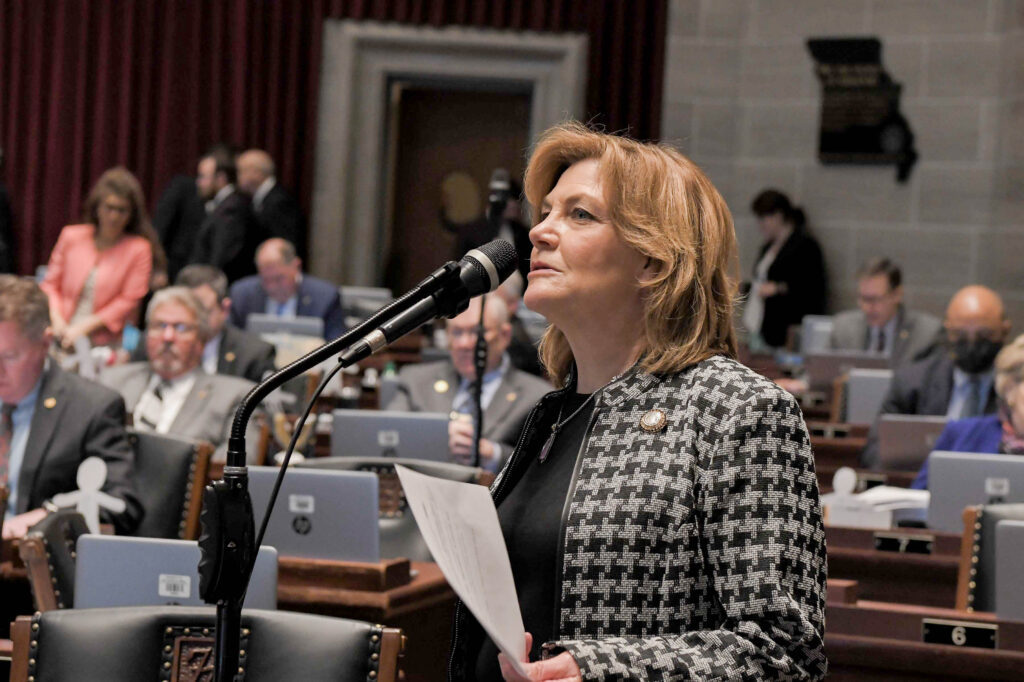Rep. Brenda Shields. R-St. Joseph, speaks during debate in the Missouri House during the 2021 legislative session (Tim Bommel/Missouri House Communications).
A Missouri House committee began a new phase Tuesday of a years-long process to create a formula to fund the state’s higher education institutions.
Led by state Rep. Brenda Shields, a Republican from St. Joseph, the Special Interim Committee on Higher Education Performance Funding is hoping to pick a performance-based formula that would determine funding while allotting for institutions’ unique missions.
Shields sponsored legislation in January pushing for the switch in higher-education funding, which passed a committee but was never debated by the full House.
The pressure to establish a formula stems from a 2022 appropriations bill that gave the Department of Higher Education and Workforce Development $450,000 to commission “a study which provides recommendations to the governor and General Assembly on public higher education performance funding models.” The department has been working with the National Center for Higher Education Management Systems since and has created reports on higher-education funding and efficiency.
“It is a long haul to make this happen if we do the testing correctly,” Shields told the committee Tuesday afternoon.
She predicted the first year of implementation would be 2027, and she aims to have a model by January that the committee can “run simulations with.”
Committee members commented that it was a challenge to create a formula for higher education — especially when term limits place a ceiling on legislators’ experience.
“I’m concerned about the technicality of what we are talking about here that is beyond my experience and perhaps ability to understand,” said state Rep. John Black, a Marshfield Republican.
Black noted that he, as well as Shields and committee member state Rep. Kevin Windham, have two years remaining in the House.
“The legislature will never understand some of these parameters at a level necessary to implement a good program. We are going to have to give over some authority to the department,” he said.
He said they will have to “convince” fellow House members to give power to the Department of Higher Education and Workforce Development.
Windham, a Democrat from Hillsdale, said they will need the Senate’s authorization.
Shields suggested expanding the group to a joint committee, incorporating senators.
Leroy Wade, deputy commissioner of the Department of Higher Education and Workforce Development, described a process of cooperation between the committee, the department and higher-education institutions, with the department serving as a liaison and source of manpower for the calculations involved.
Many of the state’s colleges sent a representative to talk to the committee Tuesday, answering what they wanted out of the funding model.
Mun Choi, president of University of Missouri System and chancellor of its flagship campus in Columbia, said his ideal formula would reward “strong outcomes such as high graduation rates and high future earnings.”
He said it should also account for pricier degree programs, comparing the cost of educating an engineering student versus a history major.
“The formula should also reflect the unique missions of all of the public universities in the state,” he said. “In fiscal year 2023 the University of Missouri System spent $600 million in expenditures to support research that led to discovery but also had impact to the region and the state.”
Elizabeth Kennedy, chair of the Council on Public Higher Education in Missouri and president of Missouri Western State University, said lawmakers should consider historic underfunding.
The Council on Public Higher Education in Missouri has 10 member schools, including the state’s two historically Black universities, Harris-Stowe State University and Lincoln University. A federal report recently showed Missouri, among other states, has been underfunding its historically Black land-grant university.
Windham said funding imbalances are a challenge as the committee discusses performance funding.
“I find it hard to talk about performance funding when I think about how institutions have been underfunded, some worse than others in the state,” he said. “The institutions that have seen significant investments in the past from the state will likely do better than most.”
Kennedy said the committee has the opportunity to study this.
Kimberly Beatty, chancellor of Metropolitan Community College, said the funding model must account for the differences between four-year institutions and community colleges. She said the current way colleges are funded has left state aid out of valuable programs.
“We do the apprenticeship programs. We have (certified nurse assistant) programs, manufacturing, welding, and all of those are apprenticeship programs,” she said. “None of those apprenticeship programs or their enrollees are considered in the current funding model.”
She said non-credit programs, which provide workforce training, provide workforce development for Missouri but are not funded at the state level.
“We’d like to see the value of workforce programs included in the funding model, whether those are credit programs or non-credit programs,” she said.
Beatty said around 20% of students are currently not counted towards full-time enrollment, as funded currently.
Full-time enrollment is one metric among many that may be incorporated into the formula. Currently, performance funding is not in effect in the budget process.
The post Missouri committee sets goal to enact performance funding formula for higher education appeared first on Missouri Independent.

